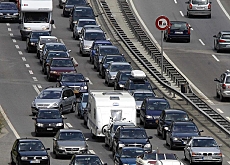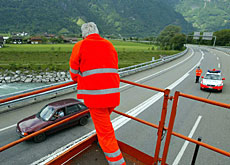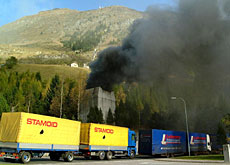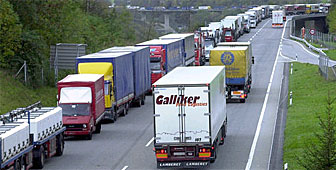Safety remains the rule at Gotthard

Five years after the fatal Gotthard road tunnel fire, safety has improved with fewer accidents, but tailbacks have increased noticeably with traffic restrictions.
Swiss authorities are now hoping that with improved security, the chances of another catastrophic accident are now reduced, even if it cannot be totally ruled out.
The fire on October 24, 2001, in which 11 people died, was caused by a head-on collision between two trucks and resulted in major structural damage to the tunnel.
To avoid a repeat of the catastrophe, restrictions were placed on the number of vehicles able to use Europe’s main north-south axis through the Alps.
No more than 1,000 cars and trucks are allowed to travel through each way every hour, and if the quota is reached, traffic is stopped. Only one lorry for three passenger vehicles is able to make the crossing.
Since the fire, no more than six million vehicles have used the tunnel annually, whereas this figure reached 6.84 million in 2000.
But at peak times, especially during the holidays, lengthy tailbacks form at the tunnel entrance causing delays that last for hours.
More vehicles could in theory use the Gotthard, but the authorities would rather not use its full capacity. “Our aim is to ensure that all those who enter the tunnel get through safely,” said the head of tunnel security, Walter Steiner.
Improvements
After security improvements worth SFr100 million ($78.9 million) were made, the number of accidents dropped. Between 2001 and 2005, there were fewer than ten per year, versus an average of 44 between 1998 and 2001.
Safety upgrades included better video surveillance and lighting, as well as improved ventilation, signposting and computer systems.
Most drivers have accepted the constraints and are fully concentrated on getting through in one piece. “I’m always amazed at how well people comply with the 50-metre distance between cars and the 150-metre rule for lorries,” added Steiner.
Drivers are also informed on how to act in event of another fire, with information posted at roadside stops at both ends of the tunnel.
But there are some drivers whose behaviour makes Steiner shake his head in disbelief. Up to 40 people per year manage to do a u-turn inside the tunnel and cross the security line despite hefty fines.
Swiss drivers get their licence suspended, while a foreigner will have to pay SFr1,300. According to the head of security, there is no escape for these offenders thanks to the improved surveillance system.
Detectors
More investments are planned for the tunnel. Thermal detectors to check if trucks are overheating before entering the Gotthard are under consideration.
The chances of a major fire breaking out again are estimated to be fairly low. A risk profile done before the tunnel opened in 1980 reckoned that on average less than one person per year could fall victim to a blaze.
It took more than 20 years for reality to catch up with estimations. The 2001 fire is considered a worst-case situation, although the authorities fear that something even worse could happen.
One of 18 possible scenarios would be for two buses to collide and go up in flames. “We can only hope this never happens,” said Steiner.
It is certainly not far-fetched. In September, nine people died in a bus accident and the ensuing fire in the Viamala tunnel in canton Graubünden.
swissinfo with agencies
Two security centres keep a watchful eye on the Gotthard road tunnel with the help of a video surveillance system.
Only 1,000 vehicles per hour can travel through the Gotthard.
Speed is limited to 80 kilometres per hour.
Passenger vehicles must stay 50 metres apart, while the distance is 150 metres for lorries.
The fire in the Gotthard road tunnel on October 24, 2001 killed 11 people: four Germans, two French citizens, two Italians, two Turkish nationals and one Swiss.
The blaze started after two trucks collided. One of the lorries crossed the centre line hitting an oncoming vehicle.
A few seconds later the fire broke out, fuelled by the contents of the two trucks. One of the drivers survived, but the other was found dead 300 metres away.
Because of the speed at which the blaze spread and heavy smoke, a number of car occupants were unable to reach safety.
It wasn’t until the next day that fire crews were able to reach the accident site and discover the bodies.

In compliance with the JTI standards
More: SWI swissinfo.ch certified by the Journalism Trust Initiative



You can find an overview of ongoing debates with our journalists here. Please join us!
If you want to start a conversation about a topic raised in this article or want to report factual errors, email us at english@swissinfo.ch.